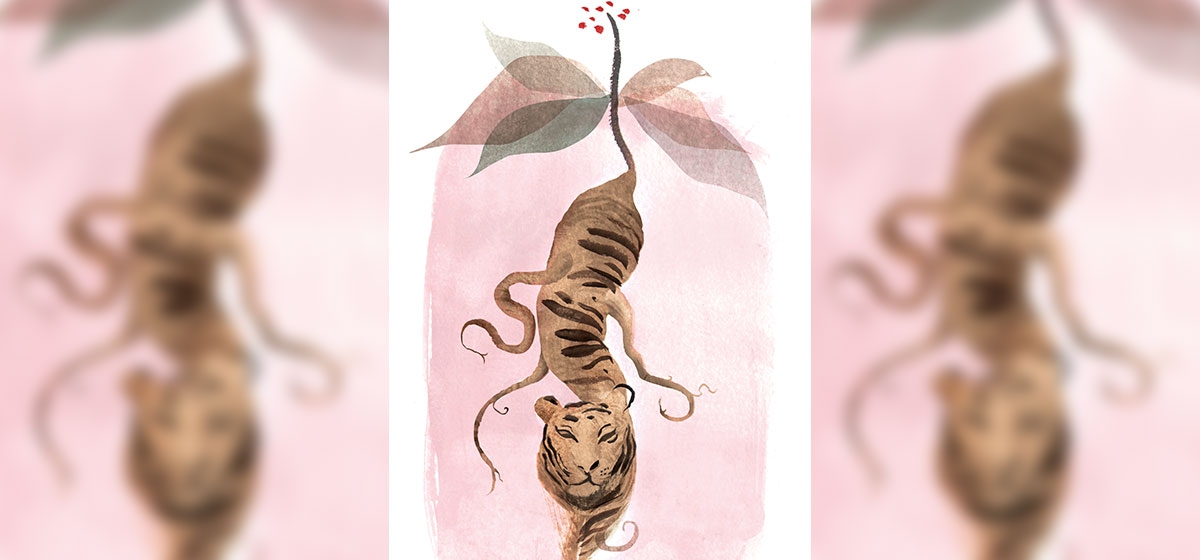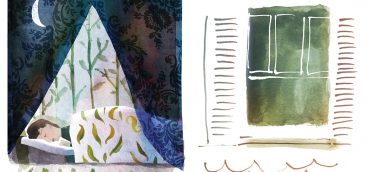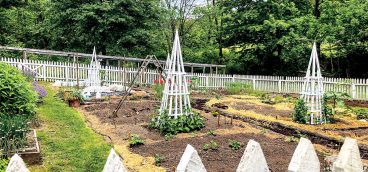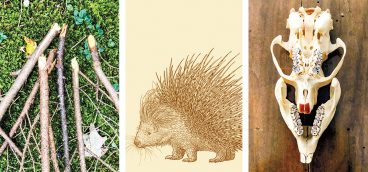Hunting Ginseng

“In passing through the mountains, I met a number of persons and pack horses going over the mountain with ginseng.” —George Washington’s Diary, 1784
I am grateful for the locals who taught me so much about rural life. Our mail carrier showed me morels, our babysitter taught me about “onion snow,” and last fall, Gary, our furnace expert, took me ginseng hunting—on our property.
Gary is in his 40s now, but he first came to our land to hunt ginseng as a boy with his uncle. “In the ’80s, when the guys were out of work, they were all in these woods hunting ginseng,” he said. Sometimes even the employed called off work because selling ginseng was more lucrative than a paycheck. “Nowadays, you still have to go to work,” Gary said, wistfully.
That’s because American ginseng (Panax quinquefolius), once abundant in the Appalachians from Georgia to Quebec and in the Midwest, has been overharvested. “Virtually anywhere there’s ginseng it’s been overhunted at some point in the past or present,” said James B. McGraw, Ph.D., and professor emeritus at West Virginia University. Still, Pennsylvania ranks in the top five to ten states supplying ginseng to Asian and American markets.
“We have some of the best, highest quality ginseng in the world growing in our woods,” said Eric Burkhart, Ph.D., a ginseng expert at Penn State University. North Central Pensylvania and the Laurel Highlands produce the biggest crop, and Fayette County, not far from our farm, is “the number one export county,” he said. Burkhart lamented that Pennsylvania “has not recognized or promoted their ginseng resource.”
Ginseng has been coveted in Asia for thousands of years and in the New World for centuries because many believe the plant to be a panacea for a variety of ills, including fatique, fertility, memory, insomnia, inflammation, erectile dysfunction, stress and more. The list is long and the results often unproven. In short, Asians regard ginseng as a tonic (yang) from which they get energy, and the Americans as a relaxant (yin). I asked McGraw whether he believed the claims and he said, simply: “Many people will say, ‘millions and millions of Asian users can’t all be wrong.’ ” Testimonials abound, including this one from a ginseng hunter in Foxfire 3: “I’ll tell you one thing, you can be in the woods and take a stomach ache or the old hungry colic, and you can just chew up some of the fine roots and swallow the juice of it and it won’t be five or ten minutes [before] your stomach’ll be just as easy as you please.”
Because of the plant’s presumed powers, Asians send trucks from New York City into the eastern U.S. mountains to purchase “barrels” of ginseng from local dealers, McGraw said. 60,000–160,000 pounds of wild ginseng is exported yearly, shipped to Hong Kong, then on to China, Korea, and points beyond. Asian buyers are “very savvy,” he said. Americans buy it too. In his book, “Ginseng, the Divine Root,” David A. Taylor writes, “Americans now spend well over $100 million a year on items that list ginseng as an ingredient.”
The taproot of this slow-growing, long-lived perennial—Burkhart said ginseng can live 100 years—is similar in shape to the human figure, and translated into Chinese means roughly “human root.” Asians prefer what’s called “truly wild” ginseng, the roots of which are “wrinkled, gnarly, and twisted,” McGraw explained. Asians pay the most for it too—in Pa., an average of $700 per pound, dried. (It takes about 205 dried roots to make a pound.)
Wild ginseng is defined as that which grows in our deciduous woods, in rich loamy soil, primarily on north- or east-facing slopes (it can be found elsewhere also). With its regional nicknames such as sang, seng, and shang, ginseng generally grows six to twelve inches high, though Burkhart has seen it “ankle to knee high.” It has a central stalk that produces an umbel of greenish-white flowers in summer, and a cluster of red berries in late summer or fall. From that stalk grow leaves, or “prongs”—ginseng vernacular—and each prong has one to five serrated leaflets. It takes five to ten years to reach the three-prong stage, which is when the plant starts to reproduce.
“Wild simulated” ginseng, which garners the next highest price, is grown by farmers in a forest setting, mimicking the wild. Burkhart believes Pennsylvanians should consider farming ginseng this way, as both a cash crop—demand is currently higher than supply—and to take pressure off the native plant. A third type—farmed ginseng—fetching the least amount of money, is grown under artificial shade and is more susceptible to disease, often requiring fertilizers and fungicides. The biggest producers of farmed ginseng are in Wisconsin, Ontario and British Columbia.
In 30 years, only one man has ever knocked on our door asking permission to hunt ginseng, but not long ago in the early morning, my husband found an elderly man, inebriated, and two boys at our tractor shed, poaching ginseng. Other hunters are probably in our woods too, perhaps during the season—perhaps not—which runs from September 1 to November 30.
During last year’s season, Gary and his already-expert 13-year-old daughter, Emily, and I went out on a cool, September afternoon, when the sun’s warmth felt delightful against the skin. Remnants of Hurricane Florence had just passed through and the skies had cleared. Goldenrod and purple aster were in bloom, and puffballs and chicken of the woods mushrooms were fruiting. I wiped spider webs from my face as we bushwhacked through the woods.
Gary led me to the general area where he used to hunt. We’ve since built a woodshed there, but otherwise haven’t altered the landscape. I scoured the forest floor, but I was not a natural “sang” hunter. I kept thinking I’d located one, but continually mistook ginseng for Virginia creeper, which vines through our woods in profusion. Other plants can fool you too: hickory seedlings, wild sarsaparilla—called fool’s sang—and Ohio buckeye. Poison ivy can mimic young ginseng, and people have mistaken ginseng for marijuana, in the event you have any of that growing in your woods…
“If you see red berries, that’s a good sign,” Gary said as I kept trying—and failing—to find the elusive plant. He told me ginseng is easier to spot later in the season when it dies back and the foliage turns yellow. Another ginseng hunter in Foxfire 3, concurred: “Now the very best time to dig it is after the first frost. From then till the leaves fall off of it. It’s a bright yellow then, and it’s a different cast of yellow from anything else in the woods, and you can tell it just as far through the woods as you can see it.”
Gary suggested I look also for companion plants such a blue cohosh, a plant I didn’t know, and Indian turnip, which I thought I didn’t know either, but was what I called jack-in-the-pulpit. Other companion plants include trillium, black cohosh, mayapple, bloodroot, and others. Some may be folklore, but Burkhart said you’re almost 100 percent guaranteed to find ginseng if you look down and see jack-in-the-pulpit and rattlesnake fern. “That’s the trifecta of right growing conditions,” he said. Some refer to rattlesnake fern as “pointer fern” or “sang fern” because the fern points directly to ginseng, but others say that’s a myth.
In our woods, ginseng grows under sugar maple, white ash or basswood, but McGraw suggested looking in particular for tulip poplars, which we have in abundance on a north-facing slope on our farm. The tulip canopy has gaps, he explained, allowing some sun on the forest floor. Ginseng doesn’t like full shade.
“Good eye,” Gary said, when, finally, after 75 minutes, I located my first ginseng—a two-pronger, not particularly impressive, about four inches off the ground. We did not dig it up. Then Emily found a big three-pronger with five red berries, and Gary dug the root, giving the plant a “wide berth” so as not to damage it. Dig carefully, McGraw advised, and make sure you get all the fine roots. And watch out for tigers. Chinese legend says the root can escape diggers by morphing into a tiger, a man, or a bird. That the root is the devil. And that hunters might perish digging it. So far, we were safe.
Gary took a bite. “Bitter,” he said.
I tasted it too. “Like a not very good carrot,” I said.
State law says you can’t pick ginseng until it has a minimum of three prongs, and the berries are red. Never harvest out of season. A license is required if the intent is to export. Good stewardship practices are numerous too, including planting the seeds at the harvest site, three quarters of an inch to an inch deep, and leaving some mature plants to insure propagation.
McGraw has studied 30 wild populations for 20 years and said ginseng is in decline. “Unless we find a way to interact with the plant in a sustainable fashion, it’s on its way to extinction.” He said the top three stressors (the plant is rated “vulnerable” in Pa.) are overharvest; the overpopulation of white-tailed deer, which eat the plant; and climate change. Poachers are an issue also, even though the plant is regulated by the U.S. Fish and Wildlife Service and since 1975 has been protected under CITES (Convention on International Trade in Endangered Species of Wild Fauna and Flora). Invasive species such as burning bush, Japanese barberry, and multiflora rose can crowd out the native plant.
McGraw believes ginseng is a resource worth preserving—and not just for humans. “I’d like to put in a plug for its value for wildlife,” he said. “The wood thrush loves ginseng fruit. At the end of the year we see wood thrushes coming to fruits that turn red. They regurgitate the seeds and disperse seeds.” He wondered if the songbird might get an energy boost from the ginseng for its long migration to Central America.
My beleaguered husband might get a boost from ginseng too. Colonel William Byrd, in his 1841 book, “Containing the History of the Dividing Line Betwixt Virginia and North Carolina,” wrote of the ginseng root: “It cheers the heart of a man that has a bad wife, and makes him look down with great composure upon the crosses of the world.”
I better go hunt some ginseng right away. Devils notwithstanding.





